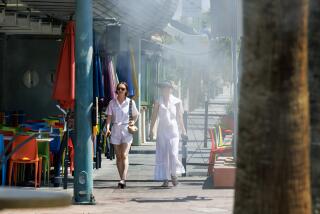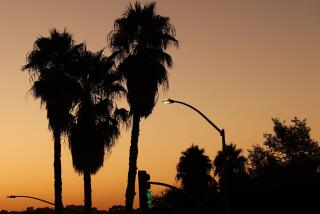Heat Topples Record Again in San Diego
- Share via
SAN DIEGO — San Diego County sizzled under record heat for the second straight day Thursday as soaring temperatures destroyed 50% of the strawberry crop and East County residents were advised to seek respite in the desert, where cooler weather prevailed.
The National Weather Service said the heat wave should continue through the weekend, with relief coming on Monday, when a cooling trend is expected to bring patches of coastal fog early in the morning. Wilbur Shigehara, forecaster for the National Weather Service in San Diego, said there is a possibility that more record temperatures will be set today and Saturday.
On Thursday, the temperature hit 98 degrees at 3 p.m. at Lindbergh Field, breaking records for April 6 and the month of April. The old record for April 6 was 89 degrees, set in 1939. The previous high for the month was 96 degrees in 1910.
Shigehara predicted a high of 93 degrees for San Diego today, which would break the old record of 85 degrees set for this date in 1962. A high of 85 degrees is forecast for Saturday, which would also break the record set for that date, in 1885.
An SDG&E; spokesman said electricity consumption was up again Thursday. By 3:30 p.m. the utility’s customers had used 2,690 megawatts of power. On Wednesday, electricity consumption peaked at 2,538 megawatts. The all-time SDG&E; record for electricity use was set last Sept. 6, when 2,831 megawatts of power were used.
The high temperatures were particularly grueling in the East County. Gillespie Field in El Cajon reported a high of 110 degrees, prompting Shigehara to issue the following advice:
“If residents of Santee and that area want to escape the heat, they might want to think about going to the desert, where temperatures were slightly cooler.”
Desert readings were reported at 102 to 105 degrees Thursday.
Scorching temperatures also destroyed 50% of the county’s strawberry crop, said Kathleen Thuner, county agriculture commissioner. According to Thuner, a county agriculture inspector recorded a pulp temperature reading of 110 degrees from one strawberry.
“The strawberries are literally cooking on the vine . . . . The crop that has been lost is the fruit on the vine, not the plant. However, there has been some concern voiced by growers that they could suffer substantial plant damage if the heat continues,” said Thuner.
Agriculture officials said it is still too early to estimate the dollar loss of the strawberry crop, which totaled about $21 million in 1987. Thuner said the Santa Ana winds have also damaged the fragile blossoms on the citrus and avocado trees. She said the yield from both crops will probably be smaller this year.
Classes Canceled Again
The record heat forced the cancellation of classes for the second straight day at two East County high schools. Students at Mt. Miguel and Granite Hills high schools only attended classes for four hours in the morning. A spokeswoman for the Grossmont Union High School District said the schools do not have air conditioning, making the classrooms “too hot and uncomfortable.” Several other East County schools also canceled classes.
Although the humidity reached a low of 9% Thursday, California Department of Forestry officials reported no fires in the county’s outlying areas. Department spokesman Jim Van Meter said residents should heed a warning from the unusually hot April weather.
“We would like people to take note of the upcoming fire season. Now is the time to prepare for the summer months ahead and people should clear a 30-foot clearance around their homes to lessen the danger from brush and grass fires,” said Van Meter.
The upcoming fire season will be particularly dangerous unless the county gets a sudden surge of rain, said Shigehara. He said the county records about half its rainfall from January to March. However, the first three months of the year have been the 10th driest on record, going back to 1850, when rainfall records were first kept in the county.
Because of the drought and unusually high demand for water, Otay Water District officials said they might be forced to ration water if the heat wave continues.
The current heat wave began Tuesday, when a high pressure developed over the West, pushing a blast of warm air into the Southland and blocking the usual sea breezes. The high pressure is expected to began weakening substantially by Sunday.
Despite the record high temperatures, lifeguard Matt Rowland said attendance at San Diego beaches was actually down from Wednesday. Rowland said about 40,000 people went to the beaches Thursday, down from Wednesday’s estimate of 50,000.
Shigehara said the cool spots in the county were Solana Beach and Mt. Laguna, where temperatures of about 80 degrees were recorded. Other hot spots included Miramar, 101 degrees; Montgomery Field, 98 degrees; Poway, 102 degrees; Coronado, 96 degrees; and San Nicholas Island, 97 degrees.
El Toro Led the Nation
In Los Angeles, it was the third day of record-shattering heat. It hit 106 degrees at the Los Angeles Civic Center on Thursday, the hottest day so far this year and the hottest April day on record. That toppled the old record for the date, set in 1962, by 15 degrees. It was the third day in a row that downtown readings topped 100.
El Toro in Orange County, where the mercury climbed to 112, was the hottest spot in the country. Other Southland readings included 110 in Ontario, 107 in Monrovia and Palm Springs, and 105 in Long Beach, Westwood, Pasadena and Northridge.
Nighttime temperatures remained at record high levels too. Thursday’s minimum reading at the Civic Center, recorded shortly before dawn, was 73 degrees, 11 degrees above the 59-year-old record for the date.
The weather was as dry as it was hot, with relative humidity ranging from a barely discernible 8% to a merely arid 34%.
“And there really won’t be any relief until next week,” said Pat Cooper, a meteorologist with WeatherData Inc., which provides forecasts for The Times.
“There will be more heat Friday, in the low 100s from downtown, out through the valleys and into the deserts,” she said. “Saturday will still be very warm, with more 100s downtown and in the valleys. Sunday will be just a little bit cooler, near 100. . . .
“It shouldn’t really begin abating until about Monday or Tuesday, when the highs will begin easing off into the 90s. And there’s no sign of rain at all.”
200,000 at Beaches
Despite the oppressive heat, hospitals reported no noticeable surge in heat-related illnesses. But there were other problems--stalled cars, closed schools, seared gardens, record power use and heat-related blackouts.
“Play it cool,” advised Dr. Edwin Newtown, a physician on duty in the emergency ward at County-USC Medical Center.
That was fine if you went to the beach, where lifeguards said more than 200,000 flocked to the sand and some of the more courageous tried a swim in the 61-degree water.
Cars overheated and fizzled out on Los Angeles freeways Thursday in what Sgt. Mike Brey of the California Highway Patrol described as a “vicious circle.”
“Sometimes when they overheat, they’re stuck in the fast lane,” he said. “That slows traffic and that makes even more people heat up.”
The problem was especially acute Thursday in the downtown area, where converging freeways were sporadically jammed with stranded, sweating motorists.
Brey offered one piece of advice that might not be popular, but it can keep your car from overheating: When stalled in traffic, turn off your air conditioner.
Electricity Use Up
People turning up air conditioners in homes, businesses and public buildings pushed electrical consumption to near record levels for the third straight day.
Southern California Edison Co. officials said a peak of 15,101 megawatts was being used by 4 p.m., eclipsing the previous high set the day before of 14,282. Edison’s all-time high is 15,987 megawatts, set Sept. 6 when the temperature reached 110 degrees.
The Los Angeles Department of Water and Power also reported a new high for April of 4,785 megawatts, beating the mark set Wednesday of 4,541. DWP’s all-time high of electricity use--4,991--was also set Sept. 6.
As the temperatures soared, DWP officials asked customers to delay the use of heat-producing appliances, such as stoves and dryers, until the evening hours.
Scattered power outages were reported.
The DWP’s Ed Freudenberg said circuits overloaded by air conditioning caused a power loss to about 1,000 customers in the Westwood area Wednesday night. The power was restored before dawn, but at 9:20 a.m. Thursday about 800 of the same customers lost power again.
Officials said none of the other outages were immediately linked to the record demands for electricity.
Times staff writers Eric Malnic, Hector Tobar, Elaine Woo and George Ramos contributed to this article.
More to Read
Sign up for Essential California
The most important California stories and recommendations in your inbox every morning.
You may occasionally receive promotional content from the Los Angeles Times.










